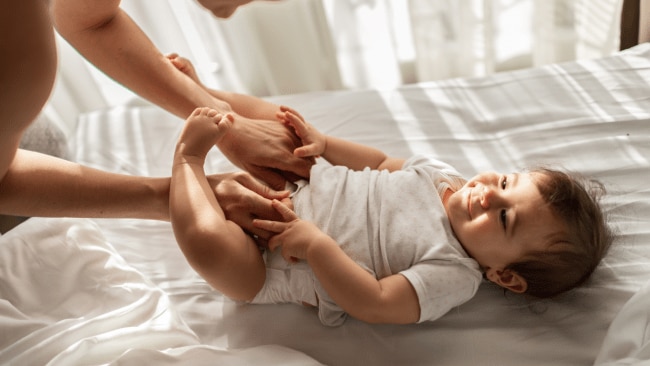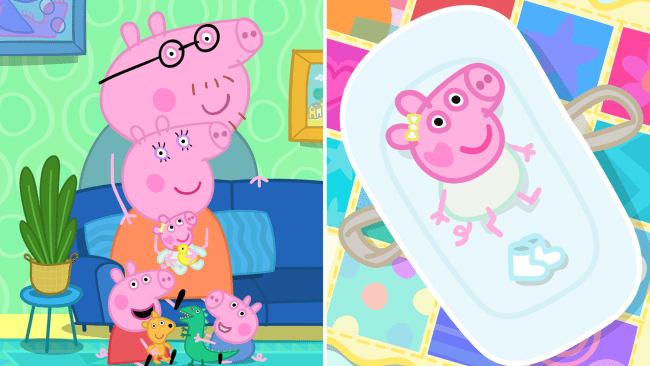What is your child’s poo telling you? Doctor explains when to worry
Black, green, or 14 days between, Dr Sam Hay tells us what's normal, and when you should call your doctor.

Lifestyle
Don't miss out on the headlines from Lifestyle. Followed categories will be added to My News.
Let’s talk about poo.
Yes, we know—it's not the most glamorous topic. But if you’re a parent, chances are you’ve spent a surprising amount of time inspecting nappies, and asking deep philosophical questions like, “Was that normal?” or “Is green poo okay?” or even “What is that?”
Good news: you’re not alone. And even better—your child’s poo can tell you a lot about what’s going on inside their body.
So grab a coffee, and let’s dive into the surprisingly revealing world of children's bowel movements.
Want to join the family? Sign up to our Kidspot newsletter for more stories like this.

RELATED: What parents need to know about kids’ growth spurts
Baby Poo 101: What to Expect in the Early Days
The Meconium Phase. In the first 24–48 hours after birth, your baby’s first few bowel movements will be thick, sticky, and black-green. This is meconium, and it's made up of everything your baby swallowed in the womb—amniotic fluid, mucus, skin cells. Delightful, right?
This stage is totally normal and usually lasts a day or two.
Breastfed vs. Formula-Fed: What Changes. Once meconium passes, poo starts to reflect your baby's diet.
Breastfed babies: Expect yellow, mustardy, often seedy stools. They’re usually soft or runny, and can happen after every feed—or sometimes just once every few days. Totally normal.
Formula-fed babies: Tends to be firmer, pastier, and a bit more tan or brown. These babies may poo a little less frequently, but again, as long as it’s soft and regular, all good.
You may see green poo occasionally, especially in breastfed bubs. It could mean they’re getting more foremilk than hindmilk (hello snack feeder!), but it’s not usually a worry unless it’s persistent or comes with other symptoms.
Fun fact: some babies can go 7-14 days between poops. Yep 7 to 14 days!?! So long as they are happy and well it's not an issue.
RELATED: South Australia moves forward with ham sandwich ban
The Toddler Years and Beyond: What’s Normal Now?
As kids grow and their diets expand (and let’s be honest—devolve into crackers and banana one week, and nothing but yoghurt the next), poo will change too.
A ‘Normal’ Bowel Routine (if there is such a thing)
- Some kids poo 3 times a day.
- Others might go only every 2–3 days.
What matters more than frequency is consistency—both in routine and in, well, the actual poo. You want soft, sausage-shaped stools that are easy to pass.
The Brisbane Poo Scale (okay, it's actually the Bristol Stool Chart)
Yes, there’s a chart. Yes, it’s brilliant. The Bristol Stool Chart classifies poo into 7 types:
- Type 1-2: Hard lumps = constipated.
- Type 3-4: Smooth sausage = ideal.
- Type 5-7: Loose, watery = diarrhoea.
Aim for Type 3 or 4. If you're consistently seeing Types 1 or 7, it's time to investigate.

RELATED: Is it chicken pox or measles?
Poo Clues: When to Be Curious, and When to Call the Doc
Here are some changes to keep an eye (and probably nose) out for:
Constipation
- Hard, dry, painful stools
- Skipping days—or weeks in older kids
- Tummy pain, bloating, reluctance to go
- Withholding behaviour (tip: kids crossing legs or hiding behind curtains = classic)
What to do: More fibre (fruit, veg, whole grains), more water, and keep them active. GPs may recommend a gentle laxative if needed.
Diarrhoea
- Runny, frequent stools
- Can be caused by viruses, food intolerance, or antibiotics
When to worry: If it lasts more than a few days, contains blood or mucus, or if your child is very tired or dehydrated (dry mouth, fewer wet nappies).
Poo Colour Warnings
- Red: Could be blood—sometimes from a small anal tear, but always worth checking.
- Black: Meconium = normal. But in older children, this might mean bleeding in the upper gut.
- White/grey: Rare, but may indicate liver issues.
Pro tip: Beetroot, blueberries, and iron supplements can all cause unusual colours. (And yes, it’s okay to panic briefly before remembering they had that purple ice cream.)
Babies and "Poosplosions"
New parents quickly learn: it’s not the frequency, it’s the force. Breastfed babies especially are known for the occasional projectile poo. As long as baby is happy, gaining weight, and the poo isn’t overly watery or mucousy, these are just stories for the baby book.
Tips for Keeping Poo (and Tummies) Happy
Fibre: Whole fruits and veg (skin on!), wholegrains, legumes.
Fluids: Water is king. Limit juice and milk to avoid overload.
Movement: Physical activity helps the gut work smoothly.
Routine: Encourage a toilet sit after meals—timing matters.
Relaxed Attitude: Don’t stress (especially during toilet training). Kids pick up on anxiety like sponges.
Final Thoughts: Don’t Fear the Poo
Whether it’s yellow and runny or brown and bouncy, your child’s poo is a window into their gut health. Most of the time, changes are harmless and fleeting - especially when tied to diet, teething, or a bug going around.
But if something feels off - especially if your child seems unwell, has ongoing constipation or diarrhoea, or changes in appetite or growth - it’s always okay to check in with your GP.
At the end of the day, your job isn’t to solve every poo mystery—but to stay observant, stay calm, and never underestimate the power of a good nappy wipe.
More Coverage
Originally published as What is your child’s poo telling you? Doctor explains when to worry









